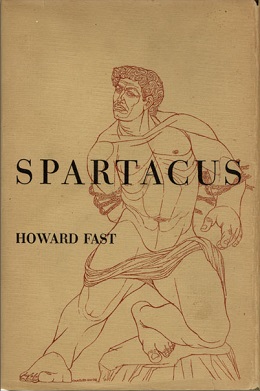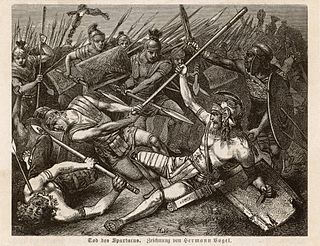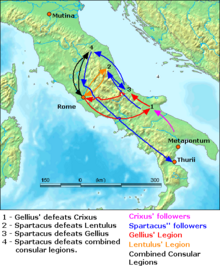This article concerns the period 79 BC – 70 BC.

Year 72 BC was a year of the pre-Julian Roman calendar. At the time it was known as the Year of the Consulship of Publicola and Lentulus. The denomination 72 BC for this year has been used since the early medieval period, when the Anno Domini calendar era became the prevalent method in Europe for naming years
Gnaeus Pompeius Strabo was a Roman general and politician, who served as consul in 89 BC. He is often referred to in English as Pompey Strabo, to distinguish him from his son, the famous Pompey the Great, or from Strabo the geographer.

The Second Servile War was an unsuccessful slave uprising against the Roman Republic on the island of Sicily. The war lasted from 104 BC until 100 BC. It was one of three Servile Wars, spaced approximately 30 years apart.

The Third Servile War, also called the Gladiator War and the War of Spartacus by Plutarch, was the last in a series of slave rebellions against the Roman Republic known as the Servile Wars. This third rebellion was the only one that directly threatened the Roman heartland of Italy. It was particularly alarming to Rome because its military seemed powerless to suppress it.

Gaius Marius "the Younger" was a Roman republican general and politician who became consul in 82 BC with Gnaeus Papirius Carbo. He was the son of the Gaius Marius who was the victor of the Jugurthine and Cimbric wars. He fought in Sulla's civil war. He committed suicide that same year at Praeneste, after his defeat by Sulla and during the city's capture by Quintus Lucretius Afella.
Crixus was a Gallic gladiator and military leader in the Third Servile War between the Roman Republic and rebel slaves. Born in Gaul, he was enslaved by the Romans under unknown circumstances and trained as a gladiator in Capua. His name means "one with curly hair" in Gaulish.

The Gladiators (1939) is the first novel by the author Arthur Koestler; it portrays the effects of the Spartacus revolt in the Roman Republic. Published in 1939, it was later reprinted in other editions.

Gnaeus Cornelius Lentulus Clodianus was a Roman politician and general who was one of two Consuls of the Republic in 72 BC along with Lucius Gellius. Closely linked to the family of Pompey, he is noted for being one of the consular generals who led Roman legions against the slave armies of Spartacus in the Third Servile War.
Lucius Gellius was a Roman politician and general who was one of two Consuls of the Republic in 72 BC along with Gnaeus Cornelius Lentulus Clodianus. A supporter of Pompey, he is noted for being one of the consular generals who led Roman legions against the slave armies of Spartacus in the Third Servile War.

Spartacus is a 1951 historical novel by American writer Howard Fast. It is about the historic slave revolt led by Spartacus around 71 BC. The book inspired the 1960 film directed by Stanley Kubrick and the 2004 TV adaptation by Robert Dornhelm.
Gaius Claudius Glaber was a military commander of the late Roman Republic, holding the office of praetor in 73 BC. During his term he was defeated in the Battle of Mount Vesuvius against the forces of Spartacus during the Third Servile War.
Oenomaus was a Gallic gladiator, who escaped from the gladiatorial school of Lentulus Batiatus in Capua. Together with Spartacus, Crixus, Castus, and Gannicus, he became one of the leaders of rebellious slaves during the Third Servile War

Spartacus is a 2004 North American miniseries directed by Robert Dornhelm and produced by Ted Kurdyla from a teleplay by Robert Schenkkan. It aired over two nights on the USA Network, and stars Goran Visnjic, Alan Bates, Angus Macfadyen, Rhona Mitra, Ian McNeice, Ross Kemp and Ben Cross. It is based on the 1951 novel of the same name by Howard Fast.

Spartacus was a Thracian gladiator (Thraex) who was one of the escaped slave leaders in the Third Servile War, a major slave uprising against the Roman Republic.
Spartacus is an American historical drama television series filmed in New Zealand that premiered on Starz on January 22, 2010, and concluded on April 12, 2013. The series was inspired by historical figure, Spartacus, a Thracian gladiator who from 73 to 71 BC led a major slave uprising against the Roman Republic departing from Capua. Executive producers Steven S. DeKnight and Robert Tapert focused on structuring the events of Spartacus' obscure early life leading up to the beginning of historical records.
Quintus Arrius was a Roman praetor in 73 BC. In the next year he should follow Gaius Verres as governor of Sicilia. But first he had to support the consuls Lucius Gellius Publicola and Gnaeus Cornelius Lentulus Clodianus in the Third Servile War against the leaders of the rebellious slaves, Spartacus and Crixus. In the battle in which Arrius conquered Crixus 20,000 slaves are said to have been killed; but Arrius was soon after defeated by Spartacus. A scholiast on Cicero said that Quintus Arrius thereafter went to Sicily to take over this province from Verres, but died on the way there. However, the scholiast does not seem to be well informed, and the veracity of his assertion is doubtful. It only can be said that Quintus Arrius did not govern Sicilia.

The Battle of Vesuvius was the first conflict of the Third Servile War which pitted the escaped slaves against a military force of militia specifically dispatched by Rome to deal with the rebellion.










